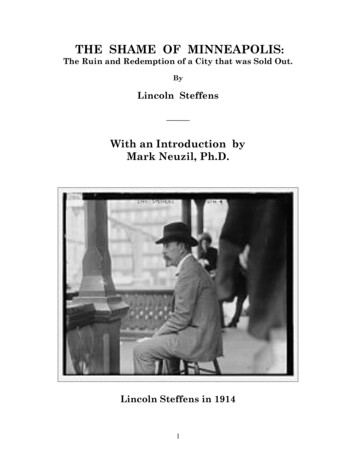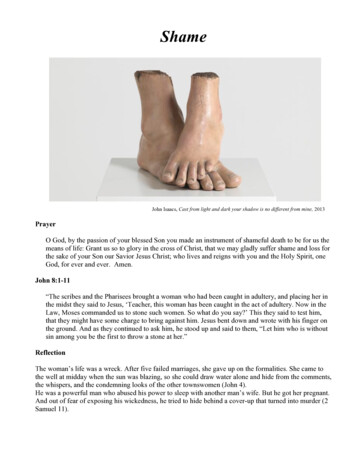
Transcription
THE SHAME OF MINNEAPOLIS:The Ruin and Redemption of a City that was Sold Out.ByLincoln SteffensWith an Introduction byMark Neuzil, Ph.D.Lincoln Steffens in 19141
Minneapolis and the Muckrakers:Lincoln Steffens and theRise of Investigative Journalism *ByMark Neuzil, Ph.D. **The muckraking era in American history is generallythought of as beginning in about 1902 and lasting untilthe end of the Taft administration or the beginning ofWorld War One, depending on which historian you read.Muckraking, in terms of journalism history, is thought ofas a crusading, reform-oriented style of the craft thatfathered the investigative reporting of modern times,from Watergate to current issues. One of the mostsignificant early muckraking stories happened here inMinneapolis, and although it is sometimes overlooked inthe general journalism histories of the time, it remainsimportant to our understanding of how the field evolved.The story was titled “The Shame of Minneapolis: TheRuin and Redemption of a City that was Sold Out,” and it* An earlier version of this paper was delivered on October 5, 2003,to an audience at the Mill City Museum in Minneapolis. It wasrevised by the author in September 2011, for the MLHP.** Mark Neuzil received his doctorate from the University ofMinnesota in 1993. He was a reporter for several years for manynewspapers, including the Minneapolis Star Tribune. In 1993, hejoined the Department of Communication and Journalism at theUniversity of St. Thomas in St. Paul. His publications include: MassMedia and Environmental Conflict: America's Green Crusades(Sage, 1996) co-authored with William Kovarik; Views of theMississippi: The Photographs of Henry Bosse (Minnesota, 2001),which won a Minnesota Book Award; A Spiritual Field Guide;Meditations for the Outdoors (Brazos Press, 2005), co-authored withBernard Brady; and The Environment and the Press: FromAdventure Writing to Advocacy (Northwestern University Press,2008).2
appeared in the January 1903 edition of McClure’sMagazine as the cover story. Its author was LincolnSteffens, a restless sort of fellow who finally found acareer as a crusading journalist after floundering at hisfirst love, writing fiction.This short talk looks at the magazine and its publisher,the author and the story.McClure’s Magazine, run by S. S. McClure, was among themost prominent of the muckraking journals. One couldargue that McClure employed the best three reporters inthe business in Steffens, Ida Tarbell and Pulitzer Prizewinner Ray Stannard Baker, who by the way grew up onthe St. Croix River.McClure and a partner founded the magazine in 1893. Thepost-Civil War era was a boom period for Americanmagazines, aided by a deep drop in postal rates, improvement in steam-powered presses and a growing, literarymiddle class of potential readers. McClure and JohnSanborn Phillips, college classmates in Illinois, alsoowned a newspaper feature syndicate and initially usedthe magazine to print articles they controlled through thesyndicate. Well-known authors such as Robert LouisStevenson, Mark Twain, Arthur Conan Doyle, WillaCather, Rudyard Kipling and Jack London appeared in itspages.Even with big-name writers and heavy use of illustrations, the magazine struggled to find sound financialfooting in the difficult financial days of the 1890s. Coverprice was 15 cents, and circulation rose and fell but nevergrew past about 40,000 copies.Tarbell and McClure struck a chord, however, with herbiographies on Napoleon and Abraham Lincoln. Following that success, Tarbell moved on to a series on John D.3
Rockefeller and the Standard Oil Company, which tookher four years and tens of thousands of dollars to write.Meanwhile, Steffens was apparently driving everyonecrazy around the office, so McClure handed him a trainticket and sent him out of town, to St. Louis.Steffens was an upper-middle class West Coast productwho attended graduate school in Germany and travelledthe continent before family connections slid him in to areporting job in New York in 1892. A few years andanother newspaper later, an inheritance left himcomfortably well off, and he gravitated to McClure’s,where he held the title of managing editor. Except hecouldn’t manage people and he wasn’t much of an editor.He did read a lot, however, and was enough of a journalistto notice a trend in reporting on urban problems,including political corruption, around the country inseveral local newspapers. He had the idea that a monthlymagazine could condense and aggregate the stories andperhaps serve some of his reform-minded impulses.In St. Louis, corruption was not too far from the surface.Steffens hired a local reporter named Claude Wetmore towrite the story, but Wetmore was nervous about repercussions and asked Steffens to add his name to the byline.“Tweed Days in St. Louis” was the result, an obviousreference to Boss Tweed in New York, the famous politicalchief and fixer.In an introduction to a book compiling the series “TheShame of the Cities,” Steffens wrote: “When I set out todescribe the corrupt systems of certain typical cities, Imeant to show simply how the people were deceived andbetrayed. But in the very first study -- St. Louis -- thestartling truth lay bare that corruption was not merelypolitical; it was financial, commercial, social; the ramifications of boodle were so complex, various, and farreaching, that one mind could hardly grasp them, and not4
even Joseph W. Folk, the tireless prosecutor, could followthem all.”Steffens then moved on to Minneapolis, leaving Wetmorebehind. “[W]hen I went next to Minneapolis alone, I couldsee more independently, without respect for persons, andthere were traces of the same phenomenon,” Steffenswrote.Police graft was his target in Minneapolis, a somewhatnarrower but more manageable story than St. Louis hadbeen. “The Shame of Minneapolis” was among the mostpopular pieces McClure’s had ever published; the Januaryedition sold out. *Steffens was perfecting a reporting style that would servehim well as he traveled to Philadelphia, Pittsburgh,Chicago and beyond. Much of the spadework had beendone by the local newspapers, so Steffens talked toreporters from the Minneapolis Journal and theMinneapolis Times. (The Tribune was closely aligned withthe power structure, the corruption of which was part ofthe exposure.) He then went to the politicians, grafters,police officers, crooks and hangers-on themselves,earning their trust and refusing to condemn (until thestory appeared in print, at least).Briefly, the story revolved around Mayor A. A. Ames, whohad been in office (and had been a Republican and then aDemocrat) on and off since the 1880s. The political spoilsdispersed by Ames including making his brother the chiefof police; a protection racket allowed brothels, saloonsand gambling houses to operate. Eventually a grand jury* The famous cover of this issue of McClure’s with a facsimile ofthe first page of the “Big Mitt Ledger,” an account book kept by aswindler of payments to city officials, is posted below. Steffens alsoreproduced it in his Autobiography published in 1931.5
was empanelled and the ground beneath Ames began togive way. Ever the popular politician, Ames evadedpunishment through five trials.It is important to note that Steffens did not uncover anyof this. Ames had resigned in July 1902; he had left townbefore Steffens arrived.Steffens did do original interviews with the participants,but culled newspaper accounts and talked to the reporters, weaving a tale from previously publishedmaterials and his own notes. The stories spurred the locallaw enforcement community to seek Ames for the (failed)prosecution.Something in the telling of the tale struck a note inreaders of a national magazine, and he continued thework across the country. Minneapolis cleaned itself up ofthe bad actors, briefly, before Prohibition and anotherband of political entrepreneurs started it back down aslippery, familiar slope. 6
7
McClure’s MagazineVOL. XXJANUARY,1903NO. 3THE SHAME OF MINNEAPOLIS *The Rescue and Redemption of a City that was Sold OutBY LINCOLN STEFFENSWHENEVER anything extraordinary is done in Americanmunicipal politics, whether for good or for evil, you cantrace it almost invariably to one man. The people do notdo it. Neither do the "gangs," "combines" or politicalparties. These are but instruments by which bosses (notleaders; we Americans are not led, but driven) rule thepeople, and commonly sell them out. But there are at leasttwo forms of autocracy which has supplanted thedemocracy here as it has everywhere it has been tried.One is that of the organized majority by which, as inTammany Hall in New York and the Republican machinein Philadelphia, the boss has normal control of more thanhalf the voters. The other is that of the adroitly managedminority. The "good people" are herded into parties andstupefied with convictions and a name, Republican orDemocrat; while the "bad people" are so organized or in* The text of this article is complete, though reformatted.Facsimiles of excerpts from the Big Mitt Ledger and ninephotographs of persons mentioned by Steffens are omitted.Punctuation and spelling are not changed.8
terested by the boss that he can wield their votes toenforce terms with party managers and decide elections.St. Louis is a conspicuous example of this form.Minneapolis is another. Colonel Ed Butler is the unscrupulous opportunist who handled the nonpartisanminority which turned St. Louis into a "boodle town." InMinneapolis "Doc" Ames was the man.Minneapolis is a New England town on the upperMississippi. The metropolis of the Northwest, it is themetropolis also of Norway and Sweden in America.Indeed, it is the second largest Scandinavian city in theworld. But Yankees, straight from Down East, settled thetown, and their New England spirit predominates. Theyhad Bayard Taylor lecture there in the early days of thesettlement; they made it the seat of the University ofMinnesota. Yet even now, when the town has grown to apopulation of more than 200,000, you feel that there issomething western about it too―a Yankee with a smallPuritan head, an open prairie heart, and a great, bigScandinavian body. The Roundhead takes the Swede andNorwegian bone out into the woods, and they cut lumberby forests, or they go out on the prairies and raise wheatand mill it into fleet-cargoes of flour. They work hard,they make money, they are sober, satisfied, busy withtheir own affairs. There isn't much time for publicbusiness. Taken together, Miles, Hans and Ole are veryAmerican. Miles insists upon strict laws, Ole and Hanswant one or two Scandinavians on their ticket. Thesethings granted, they go off on raft or reaper, leavingwhoso will to enforce the laws and run the city.The people who were left to govern the city hated aboveall things strict laws. They were the loafers, saloonkeepers, gamblers, criminals, and the thriftless poor of allnationalities. Resenting the sobriety of a staid, industrious community, and having no Irish to boss them,9
they delighted to follow the jovial pioneer doctor, AlbertAlonzo Ames. He was the "good fellow"―a genial, generous reprobate. Devery, Tweed, and many more haveexposed in vain this amiable type. "Doc" Ames, tall,straight and cheerful, attracted men, and they gave himvotes for his smiles. He stood for license. There wasnothing of the Puritan about him. His father, the sturdyold pioneer, Dr. Alfred Elisha Ames, had a strong strain ofit in him, but he moved on with his family of six sons fromGarden Prairie, Illinois, to Fort Snelling reservation, in1851, before Minneapolis was founded, and young AlbertAlonzo, who then was ten years old, grew up free, easyand tolerant. He was sent to school, then to college inChicago, and he returned home a doctor of medicinebefore he was twenty-one. As the town waxed soberer andricher, "Doc" grew gayer and more and more generous.Skillful as a surgeon, devoted as a physician, and as aman kindly, he increased his practice till he was the bestloved man in the community. He was especially good tothe poor. Anybody could summon "Doc" Ames at any hourto any distance. He went, and he gave not only hisprofessional service, but sympathy, and often charity."Richer men than you will pay your bill," he told thedestitute. So there was a basis for his "good-fellowship."There always is; these good fellows are not frauds―not inthe beginning.But there is another side to them sometimes. Ames wassunshine not to the sick and destitute only. To the viciousand the depraved also he was a comfort. If a man was ahard drinker, the good Doctor cheered him with anotherdrink; if he had stolen something, the Doctor helped toget him off. He was naturally vain; popularity developedhis love of approbation. His loose life brought disapprovalonly from the good people, so gradually the Doctor cameto enjoy best the society of the barroom and the streets.This society, flattered in turn, worshiped the good Doctor,10
and, active in politics always, put its physician into thearena.Had he been wise, or even shrewd, he might have madehimself a real power. But he wasn't calculating, only lightand frivolous, so he did not organize his forces and runmen for office. He sought office himself from the start,and he got most of the small places he wanted bychanging his party to seize the opportunity. His floatingminority, added to the regular partisan vote, wassufficient ordinarily for his useless victories. As timewent on he rose from smaller offices to be a Republicanmayor, then twice at intervals to be a Democratic mayor.He was a candidate once for Congress; he stood forgovernor once on a sort of Populist-Democrat ticket.Ames could not get anything outside of his own town, andafter his third term as mayor it was thought he was out ofpolitics altogether. He was getting old, and he was gettingworse.Like many a "good fellow" with hosts of miscellaneousfriends downtown to whom he was devoted, the goodDoctor neglected his own family. From neglect he wenton openly to separation from his wife and a secondestablishment. The climax came not long before theelection of 1900. His wife was dying, and his daughterwrote to her father a note saying that her mother wishedto see and forgive him. The messenger found him in asaloon. The Doctor read the note, laid it on the bar, andscribbled across it a sentence incredibly obscene. Hiswife died. The outraged family would not have the fatherat the funeral, but he appeared, not at the house, but in acarriage on the street. He sat across the way, with hisfeet up and a cigar in his mouth, till the funeral moved;then he circled around, crossing it and meeting it, andmaking altogether a scene which might well close anyman's career.11
It didn't end his. The people had just secured the passageof a new primary law to establish direct popular government. There were to be no more nominations byconvention. The voters were to ballot for their partycandidates. By a slip of some sort, the laws did not specifythat Republicans only should vote for Republican candidates, and only Democrats for Democratic candidates.Any voter could vote at either primary. Ames, in disrepute with his own party, the Democratic, bade hisfollowers vote for his nomination for mayor on theRepublican ticket. They all voted; not all the Republicansdid. He was nominated. Nomination is far from election,and you would say that the trick would not help him. Butthat was a presidential year, so the people of Minneapolishad to vote for Ames, the Republican candidate forMayor. Besides, Ames said he was going to reform; that hewas getting old, and wanted to close his career with agood administration. The effective argument, however,was that, since McKinley had to be elected to save thecountry, Ames must be supported for Mayor of Minneapolis. Why? The great American people cannot betrusted to scratch a ticket.Well, Minneapolis got its old mayor back, and he wasreformed. Up to this time Ames had not been very venalpersonally. He was a "spender," not a "grafter," and he wasguilty of corruption chiefly by proxy; he took the honorsand left the spoils to his followers. His administrationswere no worse than the worst. Now, however, he set outupon a career of corruption which for deliberateness,invention and avarice has never been equaled. It was as ifhe had made up his mind that he had been careless longenough, and meant to enrich his last years. He beganearly.Immediately upon his election, before he took office (onJanuary 7 [1901]), he organized a cabinet and laid plansto turn the city over to outlaws who were to work under12
police direction for the profit of his administration. Hechose for chief his brother, Colonel Fred W. Ames, whohad recently returned under a cloud from service in thePhilippines. The Colonel had commanded a Minnesotaregiment out there till he proved a coward under fire; heescaped court-martial only on the understanding that heshould resign on reaching San Francisco, whither he wasimmediately shipped. This he did not do, and hisbrother's influence at Washington saved him to be mustered out with the regiment. But he was a weak vessel forchief of police, and the mayor picked for chief of detectives an abler man, who was to direct the more difficultoperations. This was Norman W. King, a former gambler,who knew the criminals needed in the business ahead.King was to invite the Minneapolis thieves, confidencemen, pickpockets, and gamblers, and release some thatwere in the local jail. They were to be organized intogroups, according to their profession, and detectiveswere assigned to assist and direct them. The head of thegambling syndicate was to have charge of the gambling,making the terms and collecting the "graft," just as Kingand a Captain Hill were to collect from the thieves. Thecollector for women of the town was to be Irwin A.Gardner, a medical student in the Doctor's office, whowas made a special policeman for the purpose. Thesemen looked over the force, selected those men who couldbe trusted, charged them a price for their retention, andmarked for dismissal 107 men out of 225, the 107 beingthe best policemen in the department from the point ofview of the citizens who afterward reorganized the force.John Fitchette, better known as "Coffee John," aVirginian (who served on the Jeff Davis jury), the keeperof a notorious coffeehouse, was to be a captain of police,with no duties except to sell places on the police force.And they did these things that they planned―all andmore. The administration opened with the revolution onthe police force. They liberated the thieves in the local13
jail, and made known to the underworld generally that"things were doing" in Minneapolis. The incomingswindlers reported to King or his staff for instructions,and went to work, turning the "swag" over to thedetectives in charge. Gambling went on openly, anddisorderly houses multiplied under the fostering care ofGardner, the medical student. But all this was not enough.Ames dared to break openly into the municipal system ofvice protection.There was such a thing. Minneapolis, strict in its laws,forbade vices which are inevitable, then regularly permitted them under certain conditions. Legal limits, called"patrol lines," were prescribed, within which saloonsmight be opened. These ran along the river front, outthrough part of the business section, with long armsreaching into the Scandinavian quarters, north andsouth. Gambling also was confined, but more narrowly.And there were limits, also arbitrary, but not alwaysidentical with those for gambling, within which the socialevil was allowed. But the novel feature of this scheme wasthat disorderly houses were practically licensed by thecity, the women appearing before the clerk of theMunicipal Court each month to pay a "fine" of 100.Unable at first to get this "graft," Ames's man Gardner persuaded women to start houses, apartments, and, of allthings, candy stores, which sold sweets to children andtobacco to the "lumberjacks" in front, while a nefarioustraffic was carried on in the rear. But they paid Ames, notthe city, and that was all the reform administration caredabout.The revenue from all these sources must have beenenormous. It only whetted the avarice of the mayor andhis cabinet. They let gambling privileges withoutrestriction to location or "squareness"; the syndicatecould cheat and rob as it would. Peddlers and pawnbrokers, formerly licensed by the city, bought permits14
now instead from "Gardner's father," A. L. Gardner, whowas the mayor's agent in this field. Some two hundredslot machines were installed in various parts of the town,with owner's agent and mayor's agent watching andcollecting from them enough to pay the mayor 15,000 ayear as his share. Auction frauds were instituted. Opiumjoints and unlicensed saloons, called "blind pigs," wereprotected. Gardner even had a police baseball team, forwhose games tickets were sold to people who had to buythem. But the women were the easiest "graft." They werecompelled to buy illustrated biographies of the cityofficials; they had to give presents of money, jewelry andgold stars to police officers. But the money they still paiddirect to the city in fines, some 35,000 a year, fretted themayor, and at last he reached for it. He came out with adeclaration, in his old character as friend of the oppressed, that 100 a month was too much for these womento pay. They should be required to pay the city fine onlyonce in two months. This puzzled the town till it becamegenerally known that Gardner collected the other monthfor the mayor. The final outrage in this department,however, was an order of the mayor for the periodic visitsto disorderly houses, by the city's physicians, at from 5to 20 per visit. The two physicians he appointed calledwhen they willed, and more and more frequently, tilltoward the end the calls became a pure formality, withthe collections as the one and only object.In a general way all this business was known. It did notarouse the citizens, but it did attract criminals, and moreand more thieves and swindlers came hurrying toMinneapolis. Some of them saw the police, and madeterms. Some were seen by the police and invited to go towork. There was room for all. This astonishing fact thatthe government of a city asked criminals to rob thepeople is fully established. The police and the criminalshave confessed it separately. Their statements agree indetail. Detective Norbeck made the arrangement, and15
introduced the swindlers to Gardner, who, over King'shead, took the money from them. Here is the story "Billy"Edwards, a "big mitt" man, told under oath of hisreception in Minneapolis:“I had been out to the coast, and hadn’t seen Norbeck forsome time. After I returned I boarded a Minneapolis carone evening to go down to South Minneapolis to visit afriend. Norbeck and Detective DeLaitte were on the car.When Norbeck saw me he came up and shook hands, andsaid, ‘Hullo, Billy, how goes it?’ I said, ‘Not very well.’ Thehe says, ‘Things have changed since you went away. Meand Gardner are the whole thing now. Before you leftthey thought I didn’t know anything, but I turned a fewtricks, and now I’m It.’ ‘I’m glad of that, Chris,’ I said. Hesays, ‘I’ve got great things for you. I’m going to fix up ajoint for you.’ ‘That’s good,’ I said, ‘but I don’t believe youcan do it.’ ‘Oh, yes, I can,’ he replied. ‘I’m It now―Gardnerand me.’ ‘Well, if you can do it,’ says I, ‘there’s money in it.’‘How much can you pay?’ he asked. ‘Oh, 150 or 200 aweek,’ says I. ‘That settles it,’ he said; ‘I’ll take you downto see Gardner, and we’ll fix it up.’ The he made anappointment to meet me the next night, and we wentdown to Gardner’s house together.”There Gardner talked business in general, showed hisdrawer full of bills, and jokingly asked how Edwardswould like to have them. Edwards says:“I said, ‘That looks pretty good to me,’ and Gardner toldus that he had ‘collected’ the money from the women hehad on his staff, and that he was going to pay it over tothe ‘old man’ when he got back from his hunting trip nextmorning. Afterward he told me that the mayor had beenmuch pleased with our 500, and that he said everythingwas all right, and for us to go ahead.”16
“Link” Crossman, another confidence man who was withEdwards said that Gardner demanded 1,000 at first, butcompromised on 500 for the mayor, 50 for Gardner, and 50 for Norbeck. To the chief, Fred Ames, they gave tipsnow and then of 25 or 50. “The first week we ran,” saidCrossman, “I gave Fred 15. Norbeck took me down there.We shook hands, and I handed him an envelope with 15.He pulled out a list of steerers we had sent him, and saidhe wanted to go over them with me. He asked where thejoint was located. At another time I slipped 25 into hishand as he was standing in the City Hall.” But thesesmaller payments, after the first “opening, 500,” are alldown on the pages of the “big mitt” ledger This notoriousbook, which was kept by Charlie Howard, one of the “bigmitt” men, was much talked of at the subsequent trials,but was kept hidden to await the trial of the mayorhimself.The “big mitt” game was swindling by means of a stackedhand at stud poker.“Steerers” and “boosters” met“suckers” on the street, at hotels, and railway stations,won their confidence, and led them to the “joint.” Usuallythe “sucker” was called, by the amount of his loss, “the 102 man” or “the 35 man.” Roman Meix alone haddistinction among all the Minneapolis victims of going byhis own name. Having lost 775, he became known for hispersistent complaining. But they all “kicked” some. ToNorbeck at the street door was assigned the duty ofhearing their complaints, and “throwing a scare intothem. “Oh, so you’ve been gambling,” he would say. “Haveyou got a license? Well, then, you better get right out ofthis town.” Sometimes he accompanied them to thestation and saw them off. If they were not to be put offthus, he directed them to the chief of police. Fred Amestried to wear them out by keeping them waiting in theanteroom. If they outlasted him, he saw them andfrightened them with threats of all sorts of trouble forgambling without a license. Meix wanted to have payment17
on his check stopped. Ames, who had been a bank clerk,told him so, and then had the effrontery to say thatpayment on such a check could not be stopped.Burglaries were common. How many the police plannedmay never be known. Charles F. Brackett and FredMalone, police captains and detectives, were active, andone well-established crime of theirs is the robbery of thePabst Brewing Company office. They persuaded two men,one an employee, to learn the combination of the safe,open and clean it out one night, while the two officersstood guard outside.The excesses of the municipal administration became sonotorious that some of the members of it remonstratedwith the others, and certain county officers weregenuinely alarmed. No restraint followed their warnings.Sheriff Megaarden, no Puritan himself, felt constrained tointerfere, and he made some arrests of gamblers. TheAmes people turned upon him in a fury; they accused himof making overcharges in his accounts with the county forfees, and laying the evidence before Governor Van Sant,they had Megaarden removed from office. Ames offeredbribes to two county commissioners to appoint Gardnersheriff, so as to be sure of no more trouble in that quarter.This move failed, but the lesson taught Megaarden servedto clear the atmosphere, and the spoliation went on asrecklessly as ever. It became impossible.Even lawlessness must be regulated. Dr. Ames, never anorganizer, attempted no control, and his followers beganto quarrel among themselves. They deceived one another;they robbed the thieves; they robbed Ames himself. Hisbrother became dissatisfied with his share of the spoils,and formed cabals with captains who plotted against theadministration and set up disorderly houses, "panelgames," and all sorts of "grafts" of their own. The one man18
loyal to the mayor was Gardner, and Fred Ames, CaptainKing and their pals plotted the fall of the favorite. Now,anybody could get anything from the Doctor, if he couldhave him alone. The Fred Ames clique chose a time whenthe mayor was at West Baden; they filled him withsuspicion of Gardner and the fear of exposure, andinduced him to let a creature named "Reddy" Cohen,instead of Gardner, do the collecting, and pay over all themoneys, not directly, but through Fred. Gardner made atouching appeal. "I have been honest. I have paid you all,"he said to the mayor. "Fred and the rest will rob you." Thiswas true, but it was of no avail.Fred Ames was in charge at last, and he himself wentabout giving notice of the change. Three detectives werewith him when he visited the women, and here is thewomen's story, in the words of one, as it was told againand again in court: "Colonel Ames came in with thedetectives. He stepped into a side room and asked me if Ihad been paying Gardner. I told him I had, and he told menot to pay no more, but to come to his office later, and hewould let me know what to do. I went to the City Hall inabout three weeks, after Cohen had called and said hewas 'the party.' I asked the chief if it was all right to payCohen, and he said it was."The new arrangement did not work so smoothly as theold. Cohen was an oppressive collector, and Fred Ames,appealed to, was weak and lenient. He had no sure holdon the force. His captains, free of Gardner, were undermining the chief. They increased their private operations.Some of the detectives began to drink hard and neglecttheir work. Norbeck so worried the "big mitt" men bystaying away from the joint that they complained to Fredabout him. The chief rebuked Norbeck, and he promisedto "do better," but thereafter he was paid, not by the week,but by piecework―so much for each "trimmed sucker"that he ran out of town. Pro
to an audience at the Mill City Museum in Minneapolis. It was revised by the author in September 2011, for the MLHP. ** Mark Neuzil received his doctorate from the University of Minnesota in 1993. He was a reporter for several years for many newspapers, including the Minneapolis Star Tribune. In 1993, he










